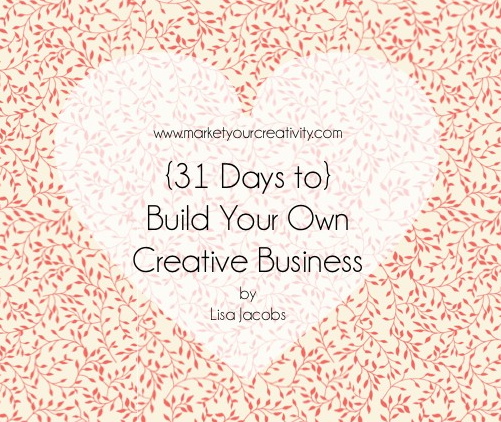Welcome back to the Build Your Own Creative Business 31 Day Series! This is {Day 3} of the program (click here to catch up from Day 1), and today I’m talking about how to gain some healthy business perspective around such a personal endeavor.
When you knit a scarf for your friend or paint a vase for your mother, that’s a hobby. When you list that creation online for sale, that hobby creation becomes business. However, most handmade sellers fail to realize this.
Your Perspective is Too Close
As I said on {Day 2} and contrary to popular belief, a saturated market is a good thing. It means there’s already high demand for what you love to make! A lot of folks question their business idea because “there’s already so many jewelry designers/ photographers/ painters/ etc out there.”
I’d like to clear up this common misconception once and for all: that’s your own insecurity, and it’s a personal belief that you’re turning into a business decision.
Let this be the most important lesson in business: since this is a creative business based on personal passion, your perspective is almost always too close. I discuss this very topic regularly inside the Luminaries Club. When you start such a business around your personal creations or services, it’s quite natural that your heart, soul, and ego will also get involved.
If you’re already the owner of a website or shop, you probably know exactly what I mean. The business feels more like it’s “in here, in front of me” at your home, rather than “out there” serving the world. And that’s something you’re better off correcting as soon as possible.
In business, you need to be open to feedback because it’s incredibly valuable outside perspective. If you’re taking that outside perspective personal, you’re more likely to be closed off and defensive to criticisms you may deem as attacks or insults.
So, the first step here is to open yourself to feedback, and remember that it’s people letting you know how to turn them into (or keep them as) customers.
Who’s Your Role Model?
One of the greatest advantages of scoping out the market you’re in is to identify some role model businesses.
In private coaching sessions, identifying a role model is one of the first tasks I assign. The reason being is that creative business owners too often chase minor problems over and again in their head with no hope of resolution. It’s like anything else that overwhelms us: too many piles of unresolved issues render us indecisive and stagnant.
A role model business is a person or corporation that does something similar to what you want to achieve. Your role model has already conquered that which currently overwhelms you, and the answers you seek are readily available with a little reconnaissance.
They’re also going to be shining examples of how to turn your product or service into a successful business. When you come across an obstacle while you’re building your creative business, you can almost always ask: what would/does my role model do? Applying their proven techniques to the way your business operates will spark new insights and ideas for growth.
Here’s how to locate a role model in your industry:
1. Name a few keywords that you associate with your creative business, product, and/or service. Google those keywords to see what businesses appear on the first few pages of search results. In addition, try to think of a few bigger businesses that already exist in your industry.
2. Identify at least one go-to big business in your field. You want somebody that is charging a strong price and creating a desirable experience for their customers.
3. Next, analyze what’s working about your role model by asking:
- How are they presenting their products online?
- What are they calling the product you make?
- How are they describing it?
- What do their customer service policies look like?
- What are they doing better than you?
- What are you doing better than them?
- How does their “about” page read?
Bigger business often leave their copywriting, marketing, and advertising research right on the table. All you have to do is dig a little deeper, and enjoy the learning curve!
Here’s an example of what you could do with role model market research (down the road): When I studied the leaders in my field, I noticed a few companies were taking out full-page advertisements in magazines catered toward people who practice yoga. Those print ads cost tens of thousands of dollars, if not more! While that level of advertising is still out of my league, I always have Facebook. How can I reach the same market on 1/1,000th of the budget? I create a Facebook ad that targets those who “like” the magazine where my role models print advertisements. I can reach the same audience at a tiny fraction of the cost.
That’s going to do it for Day 3 of the 31-day series! Again, can you believe we’re just getting started?!
Ready to continue? Move on to {Day 4} 🙂



I hope that you don’t mind me asking you but when I searched for my role model I mainly came up with books and patterns. I make crocheted and knitted jewellery. Do I go down the knitted and crochet route or jewellery to find my role model?
Answering this in an upcoming Q&A. Thanks for asking!